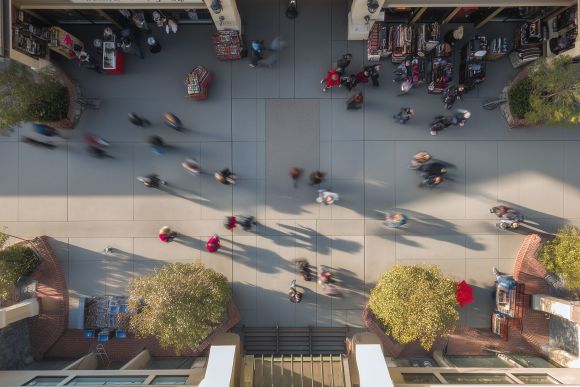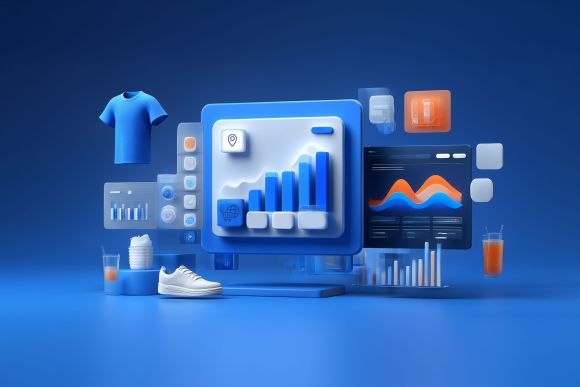Foot traffic analytics – also known as footfalls or mobility data – has become a powerful tool for brick-and-mortar businesses navigating complex customer behaviors and competitive markets. Now, thanks to advances in location intelligence platforms, foot traffic analysis is no longer limited to visitor volume estimates. Today, businesses can understand the types of people visiting through aggregated visitor profiles, where visitors are coming from, peak visit times, and other places visited during their journey.
In this blog, we’ll walk through what foot traffic analytics can show you, how it works, and how to use it to make better, faster decisions for your business.
Foot Traffic Analytics’ Benefits and Impact
Foot traffic analytics enables organizations to analyze movement patterns around physical locations. This type of location-based data reveals much more than visitor counts; it provides a window into the entire customer journey.
By tapping into aggregated, deidentified mobile device data, businesses can answer critical questions such as:
- Are my store hours aligned with peak traffic periods?
- Is my marketing strategy attracting the right audience?
- Does the visitor profile of this shopping center align with who I am trying to reach with my next location?
- Which competitors are drawing traffic away from my locations?
Ultimately, foot traffic analytics is an input for more confident, data-driven decisions, especially when paired with other data layers.
What Your Foot Traffic Analytics Data Can Show You
Foot traffic analytics, such as those provided through Buxton’s Mobilytics application, offer a detailed and actionable view of consumer behavior.
With tools like Mobilytics, you can:
- Benchmark visitor volume trends at your locations.
- Study visitor profiles to understand the types of people visiting your stores and validate that potential sites attract the right types of visitors for your brand.
- Understand trade area reach, including where your visitors originate.
- View cross-shopping behavior to see where else your customers are going.
- Benchmark competitor activity using the same metrics to monitor threats and opportunities.
Simply put, these insights enable businesses to better understand consumer interactions with the brick-and-mortar sales channel.
Related: Retail Location Strategy: Key Trends and Best Practices
Use Cases for Businesses
Foot traffic analytics is used across multiple industries and departments to answer a wide variety of questions. Here are just a few examples:
- Retailers use it to add context to store performance metrics, assess traffic trends during and after marketing campaigns.
- Restaurants analyze visit patterns to optimize hours, staffing, and delivery zones.
- Real estate professionals study visitor patterns and profiles to help validate sites before signing new leases.
- Marketers refine targeting strategies based on a deeper understanding of the types of people visiting stores and the top geographies where visitors originate.
These insights can add context to decisions based on consumer behavior.
How Foot Traffic Data Is Collected
Before you can measure anything, you need data you can trust. Foot traffic analysis begins with data collection, and at Buxton, that means sourcing aggregated, anonymized data from data from opted-in devices via mobile apps.
The process starts with defining the boundaries of your study area using geofencing. When a device enters or exits this boundary, a signal is captured. But capturing data isn’t the same as understanding it. That’s why Buxton invests heavily in data cleansing and validation to ensure what gets collected is not only compliant, but usable.
By the time data reaches our platform, it has been rigorously filtered to provide a clean foundation for further analysis. Think of this step as building a solid data layer, so everything that follows is based on truth, not noise.
Related: Clean Mobile Data Leads to Trustworthy Insights
Real-Time Foot Traffic Data Security
With privacy becoming a greater concern, it’s important to understand how foot traffic data is protected. Buxton’s foot traffic analytics are powered by anonymized and aggregated mobile device data.
Data is collected in a way that protects user privacy while still offering meaningful business insights. Foot traffic analytics are valuable, but only if they are responsibly and ethically sourced – and Buxton makes that a priority.
How Foot Traffic Is Measured
Once foot traffic data has been collected and cleaned, the next step is to enrich it with additional context. At Buxton, measurement isn’t just about counting visits—it’s about understanding the true value behind them. We combine foot traffic observations with third-party demographic, psychographic, and trade area datasets to reveal not just how many people visit, but who those visitors are, how they behave, and how trends evolve over time.
For example, knowing a location receives 1,000 visits is helpful—but knowing those 1,000 visits are from consumers who closely match your target profile provides a much clearer picture of a site’s potential. Our methodology benchmarks traffic patterns historically, compares sites across markets, and highlights whether a location’s performance is strengthening or slipping.
By layering in these insights, Buxton transforms foot traffic from simple activity metrics into actionable intelligence—giving you the confidence to make decisions grounded in customer quality, competitive context, and long-term opportunity.
Related: Keeping Up with Your Competitors: Is Location Intelligence the New Secret Weapon?
You Have Foot Traffic Insights. What Next?
Once you have access to foot traffic trends, the next step is knowing what to do with them. When you're planning your next location, launching a campaign, or analyzing performance, it’s critical to see the bigger picture.
Foot traffic analytics provides important signals, but context matters. Important decisions call for more than one data point to ensure the full picture is being considered.
That’s why at Buxton we advise our clients to look at more than just foot traffic analytics.
Combine Foot Traffic, Trade Area, and Consumer Insights for Better Decision-Making
Foot traffic data is a helpful starting point—but it becomes even more powerful when paired with trade area and consumer insights. Together, these data layers provide a more complete picture of how your location fits into the surrounding market and who your visitors truly are.
For example, a location may see high foot traffic volume, but is there high competitive density in the trade area? Are enough of your target consumers present – both as visitors to the site and as residents and workforce in the surrounding area? Real estate professionals know you shouldn’t select a site based on a single variable model, which means you shouldn’t base site selection decisions – or other key business decisions – solely on foot traffic analytics.
This layered approach allows you to:
- Visualize traffic patterns in context with nearby retail centers, shopping districts, and major roads
- Understand customer fit by comparing visitor profiles to your core customer segments
- Explore underserved trade areas with high population growth or target demographic density
- Identify opportunities to localize marketing and operational strategies based on observed behavior
This approach ensures you’re not just measuring activity but making decisions with context.
Related: Understanding Site Selection Data and Why It Matters
Take a Better Data-Driven Approach with Buxton
The quality of your decisions is only as strong as the quality of your insights. Buxton’s solutions stand out because of the depth of our foot traffic analytics. Our data is cleaned, verified, and enriched with data that puts foot traffic into context so you can make better, faster business decisions.
From benchmarking competitors to finding your next high-performing location, foot traffic insights are most effective when they’re part of a larger, integrated strategy. Explore Buxton’s Location Intelligence solutions to see how we help brands unlock the full value of foot traffic and location data.


